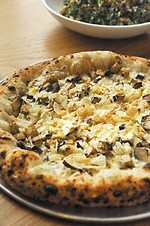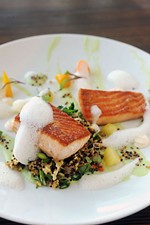It's a Flaky, Gooey, Crusty, Sugary, Savory Morning
Waking up to the delicious diversity of our town's breakfast pastries
Fri., June 3, 2005
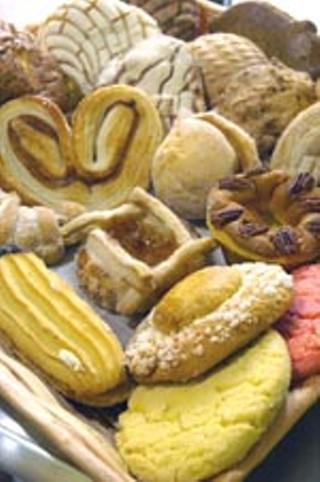
Pan Dulce
In Mexico, eating sweet pastries for breakfast or late supper – known as merienda – is a tradition that dates back to the 16th century. Pastry-making became popular in Mexico with the arrival of the French during their brief attempt at occupation that ended with the battle of Cinco de Mayo. The French influence in Mexico peaked in the early 1900s during the dictatorship of Porfirio Díaz, whose idea of modernizing and refining Mexico included a disdain for traditional Mexican cuisine in exchange for anything and everything French. Thus, bakeries appeared all over the cities, and Mexican bakers went to work, adopting French techniques and doughs such as puff pastry and meringue.
We Mexicans have a tendency to Mexicanize everything, and pan dulce, also known as bizcochos, were not the exception. Mexican ingredients such as corn flour, piloncillo (raw sugar), chocolate, and native fruits such as pineapple, sweet potato, and guava found their way into the bakeries in a classic example of culinary mestizaje, or mixing of cultures. New pastries were created in whimsical shapes and in a variety of doughs and textures, bearing colorful names often relating to their shape. For instance, in a Mexican bakery one can find marranitos (little pigs), conchas (seashells), moños (bows), or bigotes (moustaches). Even traditional French pastries such as palmiers adopted a Mexican name: orejas (ears).
In Austin, the best examples of pan dulce with exotic names and shapes are at El Fenix Bakery (6616 S. Congress, 445-5995). One step inside this tiny bakery, and you will buy everything you see just from the smell alone. Here one can find truly traditional, interior Mexican bizcochos – no pastel-colored pastries here – with names like biznaga (barrel cactus), elote (ear of corn), jaiba (crab), borracho (drunkard), and mano (hand), among many other delicious freshly baked treats.
At El Fenix, I buy their addictive cupcake-sized Mexican-style cheesecake decorated with toasted pecans. I also like the encocada, an incredibly soft coconut-flavored pastry with just the right touch of sweetness, topped with toasted coconut. The orejas are flaky, buttery, and downright perfect. Their fruit-filled empanadas are soft and crumbly, coated with granulated sugar. Their enormous bolillos, which are the best in town, are worth the drive alone.
For the largest selection of colorful and tasty pastries, look to La Mexicana (1924 S. First, 443-6369). The huge display case gleams with different colors, shapes, and textures 24 hours a day. I am absolutely partial to their ojos de toro (bull's eyes), a favorite of mine since childhood. Ojos de toro are soft pound cake rounds surrounded by a sugar-coated ring of flaky puff pastry. The combination of textures is amazing. The empanadas here are also excellent, with a dough completely different from those at El Fenix. At La Mexicana, they are golden brown and chewy, stuffed with homemade fruit fillings like pineapple, apple, and sweet potato. The conchas are pillow soft, with just the right amount of sugar icing to resemble the spiral pattern of yellow, brown, and pink seashells.
The amazing variety of Mexican pan dulce offers something for every taste, and all of them pair divinely with a cup of cafe con leche or hot chocolate. – Claudia Alarcón
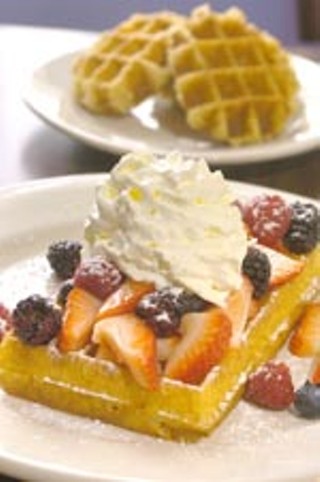
Waffles
It was a good morning when pancakes were on the menu. But on those occasions when we spied the heavy waffle iron on the counter and a bowl of pale batter resting beside it, it was a glorious birth to a fabulous day. Basically, waffles are pancakes made crispy and with warm cubby holes for harboring melting butter and syrup. Waffles are at once more posh and more down-home than pancakes. How they are able to be both at once is part of their mystique. Thomas Jefferson came back from one of his trips to France with America's first waffle iron, but Waffle House restaurants dot the South, and waffles are reputed to have been one of Elvis' favorite foods. At the 1964 World's Fair in New York, Maurice Vermersch debuted the Belgian Waffle, a big, yeasty waffle served with whipped cream and strawberries setting off a culinary sensation still celebrated today. Thanks to the miracle of the frozen waffle, mediocre waffles are standard fare in homes across America. But a waffle pulled fresh from a well-seasoned iron, golden and crispy, is another thing altogether. If you don't have the patience and appliance to create your own, some area restaurants oblige.
The mecca of the pastry is the Waffle House (7809 Ben White, east of I-35, 389-0444), which mercifully opened a shop in town to the relief of many who previously had to travel south or east for a fix. The Georgia-based chain is celebrating its 50th year of serving up crispy breakfast treats along with other diner fixins. The central and original location of Kerbey Lane Cafe (3704 Kerbey Lane, 451-1436) serves up a traditional waffle with syrup and butter in addition to its touted menu of pancakes.
Refined, elegant waffles are available at the Cafe at the Four Seasons (98 San Jacinto, 478-4500), where both the traditional and Belgian varieties are available. Likewise, the 1886 Cafe and Bakery located in the Driskill Hotel (604 Brazos, 391-7121) has a toasted pecan, banana, and blackberry jam waffle that reflects the Texas-chic style of the Austin landmark.
Denny's restaurants (all over town) offer an Americanized Belgian waffle plate, as do IHOP restaurants (various locations), with swirls of whipped cream and mounds of strawberry preserves.
For the true Belgian experience, you can't do better than to sample Brussels Sweet Feast, available at the Sunset Valley Farmers Market (Toney Burger Center, 3200 Jones Rd. on 290 West) on Saturdays from 9:30am to 1pm. Proprietor Oliver Buntinx is a native of Belgium, and he serves up two varieties of the treats. The Brussels waffle is the low-sugar, high-walled variety that can be piled with strawberries, bananas, sautéed apples, chocolate sauce, Nutella, whipped cream, powdered sugar, strawberry preserves, and/or ice cream. He also creates the Liege waffle, a pastry less common in the States but a street-food staple in Belgium. The Liege batter contains Turbinado sugar, which caramelizes during the cooking process. If that isn't enough for you, Buntinx will dip these beauties in melted chocolate, thereby creating the trifecta of delicious and sinful snacking: carbs plus fats plus chocolate. Good morning, indeed!
– Barbara Chisholm
Danish Breakfast Pastries
Danish pastries are made from a puff-pastry-like sweet yeast dough with eggs that is folded, dotted with huge amounts of butter, then rolled out and turned ("laminated"), similar to a croissant dough. Temperature of the butter and the dough is critical, and it has a reputation as being the most difficult pastry dough to master. For this reason, many commercial bakeries purchase frozen, premade dough. Finding good frozen dough is hard to do, because it's often not made with real butter but with a chemically hydrogenated fat that's easier to work with during lamination.
Once the dough is sufficiently laminated to smoothly incorporate large amounts of butter into each of the many layers, it's cut into shapes and folded around a number of different fillings (fruits, nuts, cheese mixtures, etc.), and then drizzled with a sugar glaze. A proper Danish pastry should be crisp and golden brown, with a light, leafy texture; a rich, buttery flavor; and a yellow crumb. It should be about the pastry, and not the filling.
Though the Danes get the credit for this pastry, it originally came from Vienna, known there as germbutterteig (yeast puff dough). In Denmark, it's called wienerbrød (Viennese bread). Apparently, there was an uprising of trade bakers in Austria in the mid 1800s over wanting higher wages so they wouldn't have to live in the same house with the bakery owner (a 24-hour slave situation, as the bakery was often in the same building as, or adjacent to, the living quarters.) The owners refused the raise, and the trade bakers headed north.
Many migrated to Scandinavia, teaching yeast puff dough methods to their northern brethren. It was a huge success in Scandinavia, and at the turn of the century, there was a mass migration of Scandinavians to the States. Scandinavian cooks got jobs at diners and restaurants all over the East Coast (and other parts of the country), bringing the pastry with them.
One particular Dane, Lane Klitteng, is credited with popularizing the pastry in New York City. He walked into the kitchen of Gertner's Restaurant with a recipe and a long list of fancy fillings to sell, taught the staff how to make it, and shortly after, Gertner's "Danish" pastries were the talk of the Big Apple. Klitteng then set out to cover 30 states, selling recipes and teaching as he went; in effect, he was the Johnny Appleseed of Danish pastry. In 1920, Klitteng went on to start the Danish Pastry Cooking School in NYC (a 14-day, 100-hour lesson plan), wrote Klitteng's Success Book a little later, and was known as the "world's highest-paid baker."
Austin has no Lane Klitteng, or a Gertner's, but we do have several bakeries that do the Danish justice, making the dough the correct way. Our fave is the buttery crisp goodness found at Sweetish Hill Bakery (1120 W. Sixth, 472-1347), followed closely by those from the Upper Crust Bakery (4508 Burnet Rd., 467-0102). Russell's Bakery & Coffee Bar (3339 Hancock, 419-7877), Ken's Doughnuts & Pastries (2820 Guadalupe, 320-8484), and Whole Foods Market (Sixth & Lamar, 542-2200; 9607 Research, 345-5003). All laminate their dough correctly, using butter. Central Market (4001 N. Lamar, 206-1000; 4477 S. Lamar, 899-4300) bakes some of its pastries from frozen dough, and some from house-laminated dough. Meanwhile, for a classic Danish pastry home recipe, see www.recipesource.com/ethnic/
europe/danish/dansk-wienerbrod1.html. – Mick Vann
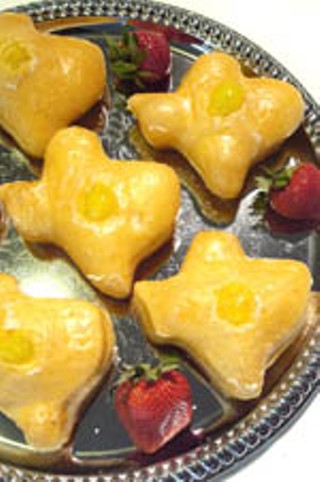
Doughnuts
When I was a student at UT many years ago, one of the favorite middle-of-the-night treats among the residents of our co-op house was a trip to Mrs. Johnson's Bakery (4909 Airport, 452-4750) for freshly made doughnuts. We'd pull away from the drive-up window and gorge ourselves on the delicious sweet treats and frosty-cold milk, enveloped in the warm cloud of yeasty aromas emanating from the little building at 3am. The shop still opens at midnight. It's an Austin trip everyone should make at least once.
Doughnuts rarely taste as good as I remember those tasting. Perhaps memory plays tricks on me, or it could be that I don't partake of the same appetite enhancement now as we did then. However, I suspect the change in flavor also has something to do with pressure from the "trans-fat police" to change the composition of the frying shortening over the years. My search for big, fluffy, hand-rolled and cut doughnuts with a real yeasty flavor led me to several shops in the Austin area. While I bow to the cult popularity of Krispy Kremes, the lighter-than-air, disappear-on-your-tongue conveyor-belt confections are not the doughnuts of my memory, although I'll have to admit the aroma around their shops is pretty seductive when the "Hot Donuts" signs are lit.
The most famous doughnuts in Central Texas have to the yellow-tinged Round Rock donuts from Lone Star Bakery (106 W. Liberty in Round Rock, 512/255-3629; 1202 FM 685 in Pflugerville, 512/670-1970). Folks have been clamoring for these babies since 1926, and a fire that destroyed the original bakery building in 2000 only increased their ardor. Business has boomed since construction of the new bakery and a second suburban outlet. The doughnuts are as marvelous as ever: hand-rolled and cut yeast dough that rises three times, a thin sugary coating, plenty of rich chocolate on top.
At campus-area mainstay Ken's Donuts (2820 Guadalupe, 320-8484), I found I was partial to the cake donuts dusted with crunchy cinnamon sugar. Just down the street from the Capitol building, the signature donut at BakerMan's Bakery (120 E. Seventh, 476-0060) is the Yellow Rose of Texas, a big, handmade beauty in the shape of Texas filled with lemon. I like these a lot. I was surprised to find the doughnuts that rocked my world came from the new Whole Foods flagship store (Sixth & Lamar, 476-1206). A team of doughnut makers arrive late at night and turn out all-natural, hand-rolled and cut dough that is fried in canola oil and paired with glazes and fillings made from scratch. You'll want to buy these early in the day and eat them all at one sitting, but that shouldn't be a problem, believe me. The plain and chocolate glazed are wonderful. My personal favorite is topped with a creamy coconut glaze and filled with a tart lemon filling. Heavenly. – V.B.W.
Kolaches
"Basically, they're dough with stuff in it," observes Dawn Orsak, Czech-Texan and Czech food expert. "Almost every culture has some variation of that." That said, however, Orsak (coordinator of the Saveur Texas Hill Country Wine & Food Festival) has perused hundreds of recipe variations and can specifically describe just what makes a good kolach. (And take note, people: In Czech, kolach is singular and kolache is plural. The common Americanism "kolaches" is a linguistic redundancy.)
Composed of soft, light, slightly sweet, elastic, yeasty dough surrounding a generous well of fruit paste, cheese, or sausage, kolache are a beloved element of Central Texas foodways, ever since the first Czech settlement in the mid-19th century. By the 20th century, there were 250 Czech communities in Texas, particularly in the Blackland Prairie farm belt east of Austin. Many of these towns still thrive, working hard to preserve Czech heritage through cultural and history centers, festivals and, of course, kolach cookoffs. For kolach fanatics en route to Dallas or Houston, there are several legendary "Czech stops," including Hruska's in Ellinger, Weikel's in La Grange, and at least three in tiny West on I-35.
Prune, poppy seed, and sweetened cheese are the classic fillings brought from Europe, but Alena Reznickova-Jimenez, Czech Republic native and now Texan-by-marriage, finds the dough a bit different here (probably due to wheat varieties and flour-production methods), and she never saw klobasnik (Czech pork sausage) in a kolach until she came to Austin. Is this popular Texas treat a New World innovation or simply a Czech regional variation? Orsak notes that most Czech-Texan families originated in Moravia near the Polish border, and that may explain the difference.
Speaking of innovation, these days it seems that just about anything goes to fill a kolach: The traditional yeast dough is a vehicle for a huge variety of flavors, both sweet and savory. At Austin's oldest emporium, the Kolache Shoppe (7113 Burnet, 458-5542, www.kolacheshop.com), owner-baker Robert Ahrens has been making 25 varieties for 25 years. In addition to the classics, some of his more unusual variations include bacon, meatball, and pineapple.
In his cheerfully painted, often flower-bedecked new shop in South Austin, Steve Frederick's Big Kolache (2407-A S. Congress, 383-9050) bakes 16 varieties. Sweet fillings are made from scratch (Maine blueberry is especially decadent), and he uses smoky Elgin hotlinks for the wrapped sausage selections.
In the central city, Massey Wallace recently stopped being a UT engineer and, at the urging of family and friends, opened Lone Star Kolaches (3800 N. Lamar, 323-3663, www.lonestarkolaches.com). In addition to a respectable variety of traditional flavors, Wallace carries innovation to the extreme in some of her 30 selections, offering such anomalies as broccoli/egg/cheese, Tuscany chicken, and barbecue beef.
At the opposite end of the spectrum, the European Bistro restaurant and bakery in Pflugerville (111 E. Main, 512/835-1919, www.hungariancatering.com) offers a mere five fillings – strawberry, apricot, cheese, sausage, ham/cheese – but like all their traditional Eastern European desserts, they are exquisite.
It's a beautiful thing that Austin neighborhoods have gotcha kolache covered, but be aware that a kolach is best eaten very fresh. Once baked, kolach dough does not age gracefully, so the earlier you arrive, the softer, more fragrant, and flavorful your kolach will be. – MM Pack
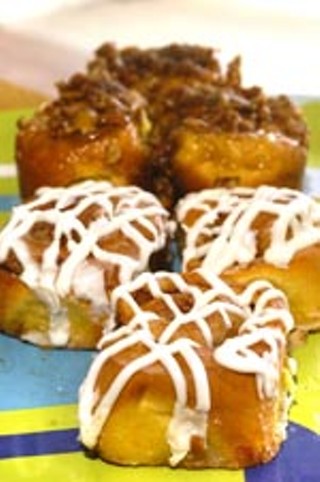
Cinnamon Rolls
I felt like Robert Duvall as Lt. Col. Bill Kilgore in Apocalypse Now, crouching on the beach, contemplating life's richness as he speaks lovingly of the aroma of a morning napalm attack. Instead, I was pondering the opulent fragrance of 13 different cinnamon rolls, all carefully heated for 12 minutes in a 300-degree oven and spread over our kitchen counter for my wife and me to appraise. I love the smell of cinnamon in the morning. Smells like ... happiness.
Thirteen cinnamon rolls and we came to some broad conclusions. First, you get a much better cinnamon roll by shopping at a specialty market. The grocery store versions (except one) ranked last on our list. The second conclusion, which came as something of a surprise to me, was that there are lots of different styles of cinnamon rolls, and I'm not talking about subtle gradations. The only resemblance our three top-ranking rolls shared was using cinnamon and sugar.
The best grocery-store cinnamon roll, and none of the others even came close, was from Whole Foods (75 cents at Sixth and Lamar, 476-1206). First off, you could tell they used a much better grade of cinnamon than the other stores. Second, it had a wonderful texture – almost like a doughnut – that offered both richness and a delightful texture. The other grocery stores had dry, unappetizing rolls. Finally, the topping seemed homemade, unlike the others, which seemed like they had come from a large restaurant-supply company in a squeeze bag. For folks who like their rolls doughy and gooey, nothing beats the gut-busting Cinnabon ($2.49, in Barton Creek Mall), the biggest and richest roll in the taste-off. Occasionally, you find a chain store that has a gazillion stores for a good reason, and Cinnabon fits that bill.
But our three favorite rolls came from local outfits and were completely different. The Upper Crust roll ($1.50 at 4508 Burnet, 467-0102) comes shaped like a short, fat croissant, but with a similar texture to a Danish. There's no syrupy frosting here. The flavor comes from sugar, butter, and cinnamon; think your Granny's Sunday cinnamon toast made into a delicious roll. The texture is a little firmer to the tooth than the others, something that allows it to be a great coffee dunker for those who, like me, don't see that as violating Miss Manners' manners.
The last two provoked a friendly fight that lasted nearly an hour as we bickered over which was the best cinnamon roll in Austin. My wife fell in love with the Kitchen Door's rolls ($1.75 at 2504 Lake Austin Blvd., 236-9200) before ever tasting them for one reason: They've found a way to keep them warm right up till the moment you're ready to buy them. A gentle amount of steam keeps the rolls moist and ready to eat, and they are special. The Kitchen Door has found the perfect halfway place between the gooey Cinnabon and the crusty Upper Crust to arrive at a texture almost like a dense croissant. Their cinnamon is top-notch, and the sweetened swirl in the middle is both generous and sprinkled with pecans. The topping is crisp, not gooey, and the best part of all, when you reheat these little marvels, the bottom forms into a praline-like richness.
The other winning roll was from Cinnamons Bakery ($1.95 in Lincoln Center, 6406 N. I-35, 452-7655), my personal favorite. Like anything worth loving with passion, this roll reveals more and more seductive powers as you make your way through its layers. The outside starts off crusty, but with enough richness that a couple of chews and it melts away. As you make your way farther into the middle, the roll becomes more and more short, until finally, the middle itself is a delicious mix of dough about the consistency of a Parker House roll, along with a heap of luscious cinnamon. As an extra benefit, they don't put their glorious frosting on until you order your roll, so you can specify how much you want. I order lots. – Wes Marshall
Pancakes
Just about every culture has its version of the pancake. In Europe during the Middle Ages, the Tuesday before lent – Shrove Tuesday – was traditionally celebrated with pancakes. Milk, sugar, and eggs were considered luxury foods, prohibited during Lent, and making pancakes became a way of emptying the larder. In 19th-century America, eating pancakes evolved around the early morning fires of logging and cowboy camps, where dedicated camp cooks would prepare them using a sourdough starter held over from the previous day's batter. These sourdough griddle cakes, enriched with heavy doses of lard, formed the foundation of the mighty breakfasts – to quote Nelson Algren – that came to emblemize Midwestern American foodways.
Pancakes today are about as regular as hamburgers. There is no shortage of them in diners and breakfast joints in just about every town in America. Really great pancakes, however, are a rarity. And even less regularly do restaurants offer a variety of different types of pancakes beyond the standard buttermilk variety. Without a doubt, the best place to find exceptional pancakes in Austin, both in terms of quality and variety, is at the Original Pancake House in North Austin (1700 W. Parmer, 873-7200). This relatively recent manifestation of a well-established Oregon-based chain makes mighty breakfasts its primary business. Its signature pancake is the sourdough variety, made with an aged starter. These are airy and tart. The Pancake House's Apple Baby and Dutch Baby pancakes are unsurpassable. Made like a popover, the former laden with caramelized apples and cinnamon, the latter sprinkled with lemon and powdered sugar, these gooey cakes are really more like some sinful dessert than a hearty breakfast. For those who prefer their pancakes more like crepes, the Original Pancake House's Swedish Pancakes are thin, eggy, and covered with lingonberry jam.
In terms of old-fashioned blueberry pancakes, it's hard to beat the Omelettry (4811 Burnet, 453-5062). Theirs are massive, moist, plentifully packed with blueberries, and smothered in butter. Equally popular are their gingerbread pancakes. These are thick, and laden with molasses and ginger. Kerbey Lane Cafe (four locations around Austin) and the Magnolia Cafe (2304 Lake Austin Blvd., 478-8645; 1920 S. Congress, 445-0000) also make a fine gingerbread pancake, which can be ordered round the clock at both restaurants. Their menus include several other varieties, as well. Kerbey Lane offers buttermilk, apple, and blueberry, while the Magnolia serves cornmeal and whole wheat pancakes. Finally, my family's idiosyncratic favorite has to be the Jakes Cakes at the Austin Diner (5408 Burnet Rd., 467-9552), made with cottage cheese and a kiss of warm spices. – Rachel Feit





